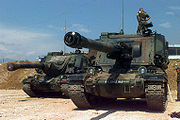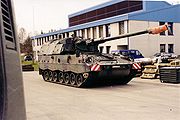
Shoot-and-scoot
Encyclopedia


Artillery
Originally applied to any group of infantry primarily armed with projectile weapons, artillery has over time become limited in meaning to refer only to those engines of war that operate by projection of munitions far beyond the range of effect of personal weapons...
tactic
Military tactics
Military tactics, the science and art of organizing an army or an air force, are the techniques for using weapons or military units in combination for engaging and defeating an enemy in battle. Changes in philosophy and technology over time have been reflected in changes to military tactics. In...
of firing at a target and then immediately moving away from the location where the shots were fired. The reason for this is to avoid counter-battery fire
Counter-battery fire
Counter-battery fire is a type of mission assigned to military artillery forces, which are given the task of locating and firing upon enemy artillery.-Background:...
- fired by enemy artillery or delivered by attack aircraft and helicopters, in order to suppress or destroy the battery or batteries. The need for such tactics in World War II became obvious from the noticeable smoke signature produced by the use of anti-tank infantry weapons such as the M1 bazooka, Panzerfaust
Panzerfaust
The Panzerfaust was an inexpensive, recoilless German anti-tank weapon of World War II. It consisted of a small, disposable preloaded launch tube firing a high explosive anti-tank warhead, operated by a single soldier...
and Panzerschreck
Panzerschreck
Panzerschreck was the popular name for the Raketenpanzerbüchse , an 88 mm calibre reusable anti-tank rocket launcher developed by Nazi Germany in World War II. Another popular nickname was Ofenrohr ....
, and also by the various models of Nebelwerfer
Nebelwerfer
The Nebelwerfer was a World War II German series of weapons originally designed to deliver chemical weapons. They were initially developed by and assigned to the Wehrmacht's so-called Chemical Troops ...
and Wurfrahmen 40
Wurfrahmen 40
The Wurfrahmen 40 was a German World War II multiple rocket launcher. It combined a vehicle such as the SdKfz 251 halftrack or captured ex-French Renault UE Chenillette with rocket artillery to form a more mobile and slightly more protected artillery piece than the towed Nebelwerfer...
German barrage rocket systems.
Shoot and scoot was originally made possible and used by Soviet Katyusha rocket artillery, whose rudimentary construction of rails on a truck chassis made it comparatively light and mobile, while its quick 7-10 second full salvo, slow reload, and complete lack of protection made switching positions its main tactic and best defense.
Shoot and scoot tactics were first adopted by NATO in the early 1960s by its nuclear artillery units using towed 8-inch Howitzers and truck-mounted MGR-1 Honest John rockets. These operated as single guns or launchers, typically deployed to a hide, came into action when given a nuclear fire mission, fired and immediately came out of action and moved to another hide adjacent to another firing position. These tactics became normal for missile units and were successfully used by Iraqi missile units in the 1991 Gulf War.
Similar tactics were adopted by Multiple Launch Rocket System (MLRS) platoons when it entered service, although in this case the launchers usually went first to a reload site after firing. It may be used by Indian Pinaka MBRL
Pinaka Multi Barrel Rocket Launcher
Pinaka is a multiple rocket launcher produced in India and developed by the Defence Research and Development Organisation for the Indian Army. The system has a maximum range of 39–40 km and can fire a salvo of 12 HE rockets in 44 seconds, neutralizing a target area of 3.9 km2...
or Russia
Russia
Russia or , officially known as both Russia and the Russian Federation , is a country in northern Eurasia. It is a federal semi-presidential republic, comprising 83 federal subjects...
n Grad
BM-21
The BM-21 launch vehicle , a Soviet truck-mounted 122 mm multiple rocket launcher, and a M-21OF rocket were developed in the early 1960s. BM stands for boyevaya mashina, ‘combat vehicle’, and the nickname means ‘hail’. The complete system with the BM-21 launch vehicle and the M-21OF rocket...
, Uragan
BM-27
The BM-27 Uragan is a self-propelled multiple rocket launcher system designed in the Soviet Union. It began its service with the Soviet Army in the late 1970s, as its first modern spin and fin stabilized heavy multiple rocket launcher. This system is capable of launching 220 mm rockets from...
and Smerch, although originally systems like Grad used more traditional tactics.
The tactic has also been adapted and adopted for more general use with self-propelled gun
Self-propelled gun
A self-propelled gun is form of self-propelled artillery, and in modern use is usually used to refer to artillery pieces such as howitzers....
batteries (such as the US M109 Paladin
M109 howitzer
The M109 is an American-made self-propelled 155 mm howitzer, first introduced in the early 1960s. It was upgraded a number of times to today's M109A6 Paladin...
or German PzH2000). However, to be fully effective it requires guns able to determine their own orientation and position coordinates without an external device (director or aiming circle) and survey.
A refined version are gun manoeuvre areas developed by UK for use by AS90 batteries when the counter-battery threat is high. These areas cover several square kilometres and the guns move around in them in pairs. The difficult decision is deciding how long guns can remain in one place before moving. This requires judgement about the enemy's counter-battery responsiveness. In these areas, the battery's command elements remain in one place and there are various options for replenishing the guns' on-board ammunition. The tactic is affected by the rate of fire of the manoeuvring guns and the time it takes them to come out of action. However, it is also very wearing on the gun crews and for sustained use relief crews are essential.
Non-autonomous guns can use the tactic, but it is far less effective because it requires each firing position be surveyed before the guns arrive and external orientation when they arrive, which may mean the guns move in larger groups. These preparations take time and can mean the guns are out of action for longer than they are in-action, although if the enemy's counter-battery capability is limited, the tactic can be effective.
South African Defence Force
South African Defence Force
The South African Defence Force was the South African armed forces from 1957 until 1994. The former Union Defence Force was renamed to the South African Defence Force in the Defence Act of 1957...
G6 Howitzer
G6 howitzer
The G6 self-propelled howitzer is a South African artillery piece, developed around the ordnance of the G5 howitzer. It is one of the most powerful self-propelled guns on a wheeled chassis....
s used the technique very effectively in Angola against Cuban forces in the Battle of Cuito Cuanavale
Battle of Cuito Cuanavale
The Battle of Cuito Cuanavale in 1987/88 was an important episode in the Angolan Civil War . Between 9 September and 7 October 1987, the Angolan Army , in an attempt to finally subdue the Angolan insurgent movement UNITA in south-eastern Angola, was decisively repelled in a series of battles at the...
.
Shoot and scoot by non-artillery units
Shoot and scoot is also the name of the tactic used by infantry and other forces (e.g. light armoured recon elements) of immediately returning fire and then retiring on contact with the enemy. This is common practice with reconnaissance patrols whose main aim is information, not combat. Typically on contact each member of an infantry patrol will fire one magazine at the enemy and then retire to a pre-agreed rendezvous. The patrol may also drop counter chase deterrents such as mines and grenades behind them, or employ other weapons apart from their small arms, such as white phosphorus grenades (which produce smoke as well as incendiary/fragmentation effects) to break contact prior to or whilst retiring.See also
- Artillery (Counter-battery fire)
- Counter-battery fireCounter-battery fireCounter-battery fire is a type of mission assigned to military artillery forces, which are given the task of locating and firing upon enemy artillery.-Background:...

